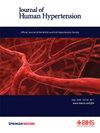动态、等长和联合阻力训练对接受治疗的男性高血压患者流动血压的影响:随机对照试验。
IF 3.4
4区 医学
Q2 PERIPHERAL VASCULAR DISEASE
引用次数: 0
摘要
动态血压(ABP)监测是诊断和管理高血压的普遍建议。动态阻力训练(DRT)和等长手握力训练(IHT)已被推荐用于高血压治疗,但它们对 ABP 的影响却鲜有研究。此外,联合动态和等长手握阻力训练(CRT)可能会产生叠加效应,但尚未进行测试。因此,本随机对照试验旨在评估 DRT、IHT 和 CRT 对平均 ABP 和 ABP 变异性的影响。59 名接受治疗的男性高血压患者被随机分配到四组中的一组:DRT(8 次动态阻力练习,1RM 的 50%,3 组直至中度疲劳)、IHT(4 组 2 分钟等长手握练习,MVC 为 30%)、CRT(DRT + IHT)和对照组(CON - 30 分钟拉伸)。干预每周 3 次,持续 10 周,在干预前后对 ABP 进行评估。采用方差分析和方差分析调整干预前的数值进行分析。在整个研究过程中,两组 24 小时、清醒时和睡眠时的平均血压均无变化(均为 P > 0.05)。夜间血压下降以及 ABP 的标准差、变异系数和平均实际变异性在两组中也没有显著变化(均为 P 0.05)。对于接受治疗的男性高血压患者,10 周的 DRT、IHT 或 CRT 既不会降低 ABP 水平,也不会改变 ABP 的变异性。本文章由计算机程序翻译,如有差异,请以英文原文为准。

Effects of dynamic, isometric, and combined resistance training on ambulatory blood pressure in treated men with hypertension: a randomized controlled trial
Ambulatory blood pressure (ABP) monitoring is a widespread recommendation for the diagnosis and management of hypertension. Dynamic resistance training (DRT) and isometric handgrip training (IHT) have been recommended for hypertension treatment, but their effects on ABP have been poorly studied. Additionally, combined dynamic and isometric handgrip resistance training (CRT) could produce an additive effect that has yet to be tested. Thus, this randomized controlled trial was designed to evaluate the effects of DRT, IHT and CRT on mean ABP and ABP variability. Fifty-nine treated men with hypertension were randomly allocated to 1 of four groups: DRT (8 dynamic resistance exercises, 50% of 1RM, 3 sets until moderate fatigue), IHT (4 sets of 2 min of isometric handgrip at 30% of MVC), CRT (DRT + IHT) and control (CON – 30 min of stretching). Interventions occurred 3 times/week for 10 weeks, and ABP was assessed before and after the interventions. ANOVAs and ANCOVAs adjusted for pre-intervention values were employed for analysis. Mean 24-h, awake and asleep BPs did not change in either group throughout the study (all, P > 0.05). Nocturnal BP fall as well as the standard deviation, coefficient of variation and the average real variability of ABP also did not change significantly in either group (all, P < 0.05). Changes in all these parameters adjusted to the pre-intervention values were also similar among the four groups (all, p > 0.05). In treated men with hypertension, 10 weeks of DRT, IHT or CRT does not decrease ABP levels nor change ABP variability.
求助全文
通过发布文献求助,成功后即可免费获取论文全文。
去求助
来源期刊

Journal of Human Hypertension
医学-外周血管病
CiteScore
5.20
自引率
3.70%
发文量
126
审稿时长
6-12 weeks
期刊介绍:
Journal of Human Hypertension is published monthly and is of interest to health care professionals who deal with hypertension (specialists, internists, primary care physicians) and public health workers. We believe that our patients benefit from robust scientific data that are based on well conducted clinical trials. We also believe that basic sciences are the foundations on which we build our knowledge of clinical conditions and their management. Towards this end, although we are primarily a clinical based journal, we also welcome suitable basic sciences studies that promote our understanding of human hypertension.
The journal aims to perform the dual role of increasing knowledge in the field of high blood pressure as well as improving the standard of care of patients. The editors will consider for publication all suitable papers dealing directly or indirectly with clinical aspects of hypertension, including but not limited to epidemiology, pathophysiology, therapeutics and basic sciences involving human subjects or tissues. We also consider papers from all specialties such as ophthalmology, cardiology, nephrology, obstetrics and stroke medicine that deal with the various aspects of hypertension and its complications.
 求助内容:
求助内容: 应助结果提醒方式:
应助结果提醒方式:


